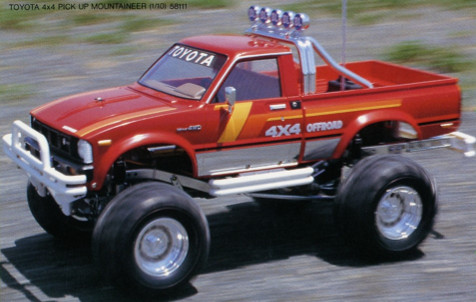The 3 Speed platform
Flashback: let's get back to the very beginning of the 80's ![]()
The name of this platform is not official: here again, this is the name fans gave it, including for the second generation in 2006 that I chose to review later in this article. This is a series of amazing and outstanding models, (almost) unique in the world of RC.
In 1981, Tamiya released their kit number 58028 (RA-1028 at the time) Toyota 4x4 Pickup Hi-Lux kit: 3 more kits will follow until 1992, and 20 years later, Tamiya re-released the iconic Bruiser and Montaineer.
58028 Toyota 4x4 Pickup Hi-Lux (1981)
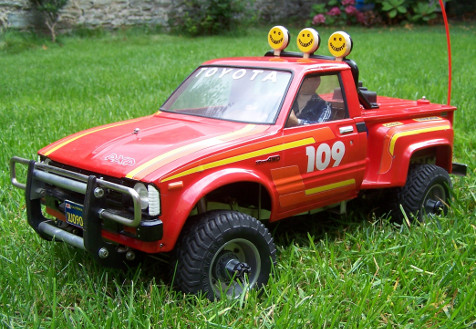
58029 Blazing Blazer (1982)
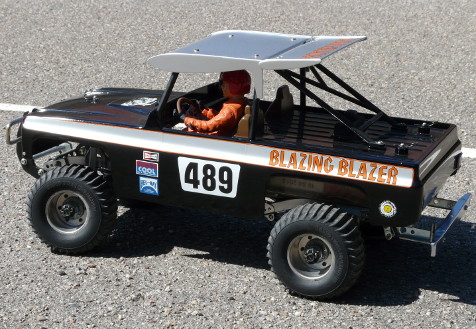
58048 Toyota 4x4 Pickup Bruiser (1985)
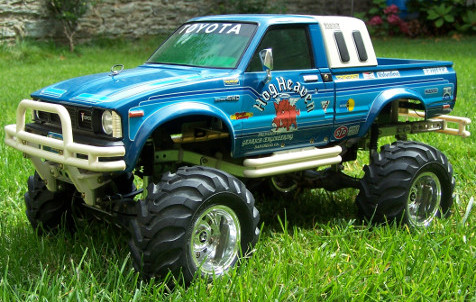
In order to better understand and appreciate this series of models, it has to be said that such a kind of models had never been released before. Ever. The 3 Speed concept (hence the name given by fans) was a first in RC history, a complexity never reached so far. More than this, realism was the keyword for these models: 4WD on first gear for clearing obstacles or slippery terrain, then 2WD on the second and third speed for more speed. The quest for details and scale-accuracy was such that these models were not equipped with differentials... because it was technically impossible at the time to make them small enough to fit the true-scale sized axles. In addition, the chassis was fitted with a waterproof box to perfectly protect electronics: the models could really drive in any condition. For all fans, the 3 Speed transmission was a true piece of mechanical jewelry.
The two first models were probably the most accomplished of the series, despite the Blazing Blazer being some sort of “economical” version. In fact, the latter did not have the semi-electronic speed controller, but a purely mechanical unit instead: here, we are talking about a real speed controller (velocity), not about gear ratio. Both first models also had the front wheels that could be manually locked (or unlocked). In short, the front wheels became free wheels once unlocked from the driveshafts, which was interesting both to improve turning radius and not to stress the mechanics on high-grip surfaces. This system is very realistic because many real-size 4WD vehicles are equipped with such a system. The Bruiser and Mountaineer did not benefit from the front free wheeling hubs but they were equipped with a Mabuchi 750 motor that provided much more torque than the standard 540 that equipped the two first models of the series.
Here is a gallery of over a dozen of high-res period documents about the 3 Speed models:
I also suggest you visit my Youtube channel were several period promotional videos are hosted.
Unfortunately, these models would never remain available for long: the production of the Toyota Hilux and Blazing Blazer stopped in 1985 when the Bruiser was released. The Bruiser production run was the longest of the series since it stopped in 1992, when the Mountaineer was released. As for the Mountaineer, the production stopped in 1995.
Fans will need to be patient until 2006 to be offered again a 3 Speed transmission, but this modern version will be reviewed in the next page of this article. However, Six years after that, Tamiya unveiled the Bruiser and Mountaineer re-releases:
58519 Toyota 4x4 Pick-Up Bruiser (RN36) (2012)
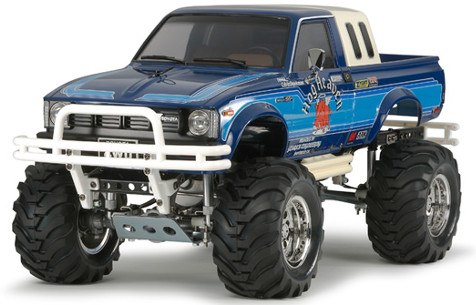
84386 Toyota Mountain Rider (2014)
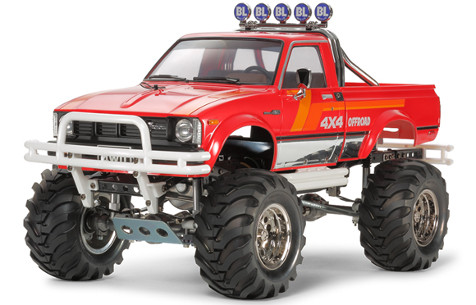
Another high-res gallery of photos about the re-releases:
The re-releases are true to the original transmission, with several improvements: lockable front and rear differentials (the first series didn't have) and the use of a standard Mabuchi 540 instead of the very specific Mabuchi 750. Despite these improvements, the re-released version are really true to their iconic original versions.
Conclusion on the 3 Speed platform
There are 3 different phases in the history of this platform: the first one with the 2 first models, the second one with the two next models, and then a third one with the re-releases mostly based upon the second phase.
The Toyota Hilux and Blazing Blazer are the most iconic of all, the most representative of Tamiya unique and specific know-how: breath-taking scale-realistic models. Here, scale-realism was focused on the bodyshells and the mechanical aspects to the point that the models were not equipped with differentials because they would have been too big to respect the true scale size of the axles. The chassis itself was a true replica of the ladder-frame and leaf-spring suspension used by real-size models. Overall, these two models were models in motion, realistic up to their chassis, the mechanical aspects and the free wheel hubs, at the price of their handling on terrain. Indeed, these models did not handle either great or in a very realistic manner because of their too stiff suspension. That was a deliberate choice from the designers and technical limits of the period technology.
The Toyota Bruiser and Mountaineer were evolutions of this architecture, in particular to offer more torque (thanks to the Mabuchi 750) and an improved suspension by the use of dampers in addition to the leaf springs. Lately, the re-released versions introduced the last technical evolution, mixing the best of the original versions with more modern techniques.
The commercial success of this series was somewhat limited by the high price tags of the models and their limited handling abilities, as the short sale periods suggest. However, these models are extremely important because they forged Tamiya's reputation in RC scale-realism: beyond their already proven capacity to reproduce scale-realistic bodyshells, Tamiya designers added the mechanical scale-realism, including by sacrificing “performance” of the models in the name of scale-realism. In this aspect, these models remain unmatched in all RC history: no other manufacturer could match such a “tour de force” and none has ever tried to compete with Tamiya in this matter. Apart from the considerable know-how required, the low economical perspectives to expect from such models probably dissuade anyone from trying.
Related article:




